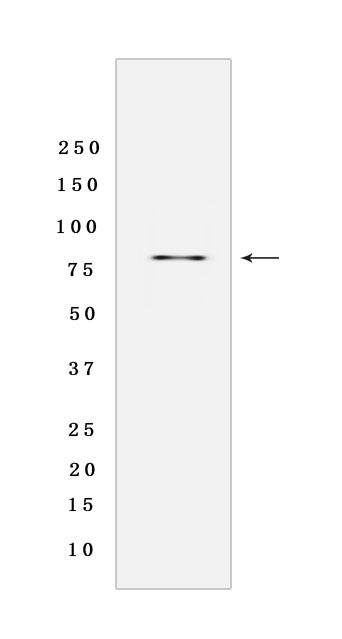CD36 Rabbit mAb [80V2]Cat NO.: A84087
Western blot(SDS PAGE) analysis of extracts from Mouse heart tissue lysateUsing CD36 Rabbit mAb [80V2] at dilution of 1:1000 incubated at 4℃ over night.
Product information
Protein names :Cd36,CD36_MOUSE,Platelet glycoprotein 4
UniProtID :Q08857
MASS(da) :52698
MW(kDa) :80kDa
Form :Liquid
Purification :Protein A purification
Host :Rabbit IgG
Isotype :IgG
sensitivity :Endogenous
Reactivity :Mouse,Rat
- ApplicationDilution
- 免疫印迹(WB)1:1000-2000
- The optimal dilutions should be determined by the end user
Specificity :Antibody is produced by immunizing animals with a synthetic peptide of Mouse CD36.
Storage :Antibody store in 10 mM PBS, 0.5mg/ml BSA, 50% glycerol. Shipped at 4°C. Store at-20°C or -80°C. Products are valid for one natural year of receipt.Avoid repeated freeze / thaw cycles.
WB Positive detected :Mouse heart tissue lysate
Function : Multifunctional glycoprotein that acts as receptor for a broad range of ligands. Ligands can be of proteinaceous nature like thrombospondin, fibronectin, collagen or amyloid-beta as well as of lipidic nature such as oxidized low-density lipoprotein (oxLDL), anionic phospholipids, long-chain fatty acids and bacterial diacylated lipopeptides (PubMed:7685021). They are generally multivalent and can therefore engage multiple receptors simultaneously, the resulting formation of CD36 clusters initiates signal transduction and internalization of receptor-ligand complexes. The dependency on coreceptor signaling is strongly ligand specific. Cellular responses to these ligands are involved in angiogenesis, inflammatory response, fatty acid metabolism, taste and dietary fat processing in the intestine (Probable) (PubMed:19847289, PubMed:20037584, PubMed:23395392). Binds long-chain fatty acids and facilitates their transport into cells, thus participating in muscle lipid utilization, adipose energy storage, and gut fat absorption (PubMed:30605677). Mechanistically, binding of fatty acids activates downstream kinase LYN, which phosphorylates the palmitoyltransferase ZDHHC5 and inactivates it resulting in the subsequent depalmitoylation of CD36 and caveolar endocytosis (By similarity). In the small intestine, plays a role in proximal absorption of dietary fatty acid and cholesterol for optimal chylomicron formation, possibly through the activation of MAPK1/3 (ERK1/2) signaling pathway (By similarity) (PubMed:17507371, PubMed:18753675, PubMed:21610069). Involved in oral fat perception and preferences (PubMed:16276419). Detection into the tongue of long-chain fatty acids leads to a rapid and sustained rise in flux and protein content of pancreatobiliary secretions (By similarity) (PubMed:16276419). In taste receptor cells, mediates the induction of an increase in intracellular calcium levels by long-chain fatty acids, leading to the activation of the gustatory neurons in the nucleus of the solitary tract (PubMed:18162488). Important factor in both ventromedial hypothalamus neuronal sensing of long-chain fatty acid and the regulation of energy and glucose homeostasis (By similarity) (PubMed:23557700). Receptor for thrombospondins, THBS1 and THBS2, mediating their antiangiogenic effects (PubMed:15748999). As a coreceptor for TLR4:TLR6 heterodimer, promotes inflammation in monocytes/macrophages. Upon ligand binding, such as oxLDL or amyloid-beta 42, interacts with the heterodimer TLR4:TLR6, the complex is internalized and triggers inflammatory response, leading to NF-kappa-B-dependent production of CXCL1, CXCL2 and CCL9 cytokines, via MYD88 signaling pathway, and CCL5 cytokine, via TICAM1 signaling pathway, as well as IL1B secretion, through the priming and activation of the NLRP3 inflammasome (PubMed:20037584, PubMed:23812099). Selective and nonredundant sensor of microbial diacylated lipopeptide that signal via TLR2:TLR6 heterodimer, this cluster triggers signaling from the cell surface, leading to the NF-kappa-B-dependent production of TNF, via MYD88 signaling pathway and subsequently is targeted to the Golgi in a lipid-raft dependent pathway (By similarity) (PubMed:15690042, PubMed:19847289).., (Microbial infection) Acts as an accessory receptor for M.tuberculosis lipoprotein LprA, in conjunction with coreceptors TLR2 and TLR1,the lipoprotein acts as an agonist to modulate antigen presenting cell functions in response to the pathogen (PubMed:19362712). Directly mediates cytoadherence of Plasmodium falciparum parasitized erythrocytes and the internalization of particles independently of TLR signaling (PubMed:19864601, PubMed:23395392). Mediates uptake of E.coli and S.aureus but has no effect on uptake of M.fortuitum (PubMed:16020694)..
Tissue specificity :Expressed in the apical side of lingual taste bud cells of the circumvallate papillae (PubMed:16276419, PubMed:21901153). Highly expressed in the intestine on the luminal surface of enterocytes. In small intestines expression levels follow a steep decreasing gradient from proximal to distal segments (PubMed:17507371). Expressed in macrophages (PubMed:23395392, PubMed:23812099). Cell surface expression detected in lung alveolar macrophages, dendritic macrophages and lung macrophages (at protein level) (PubMed:19362712)..
Subcellular locationi :Cell membrane,Multi-pass membrane protein. Apical cell membrane. Membrane raft. Golgi apparatus.
IMPORTANT: For western blots, incubate membrane with diluted primary antibody in 1% w/v BSA, 1X TBST at 4°C overnight.


